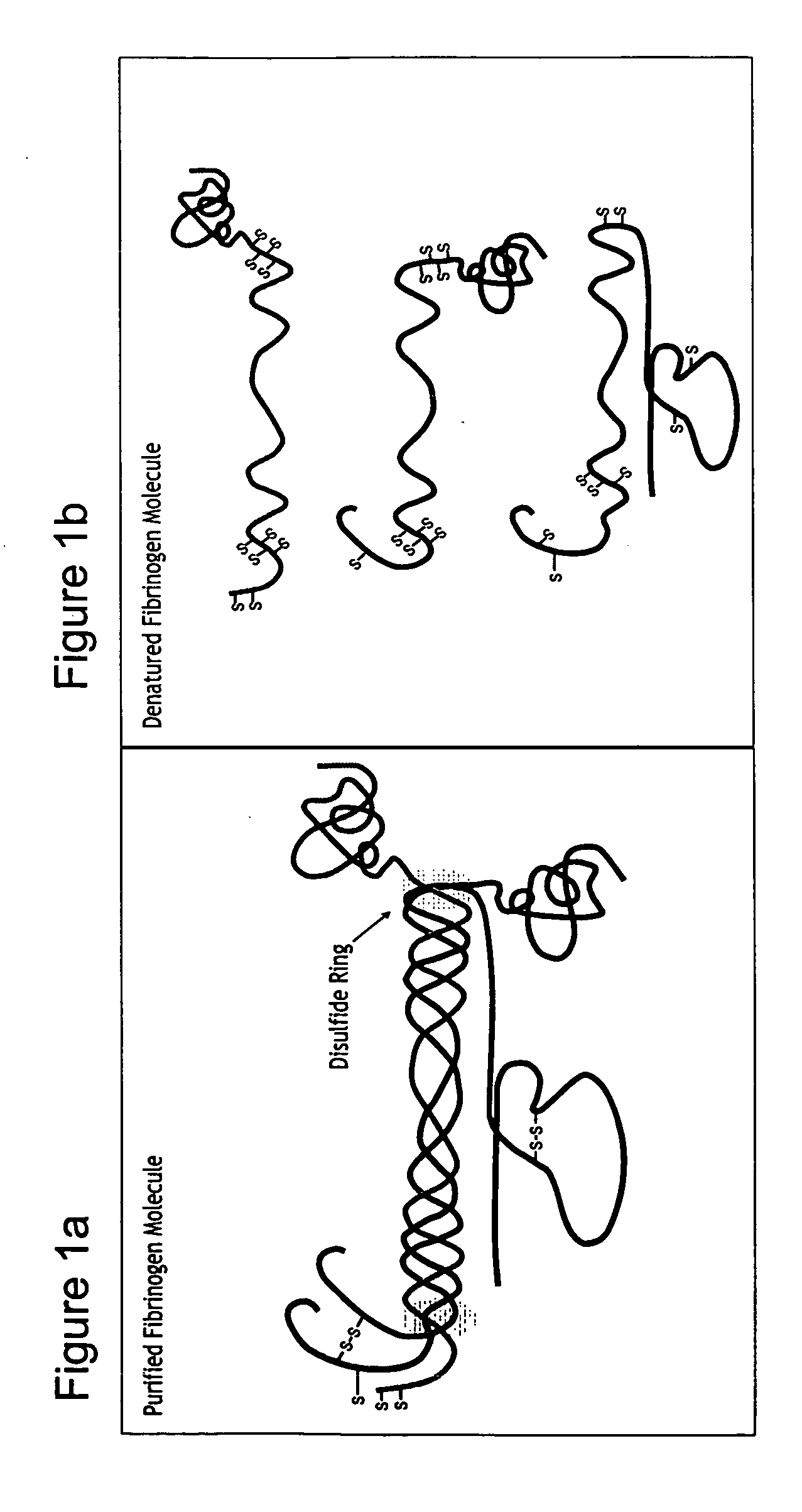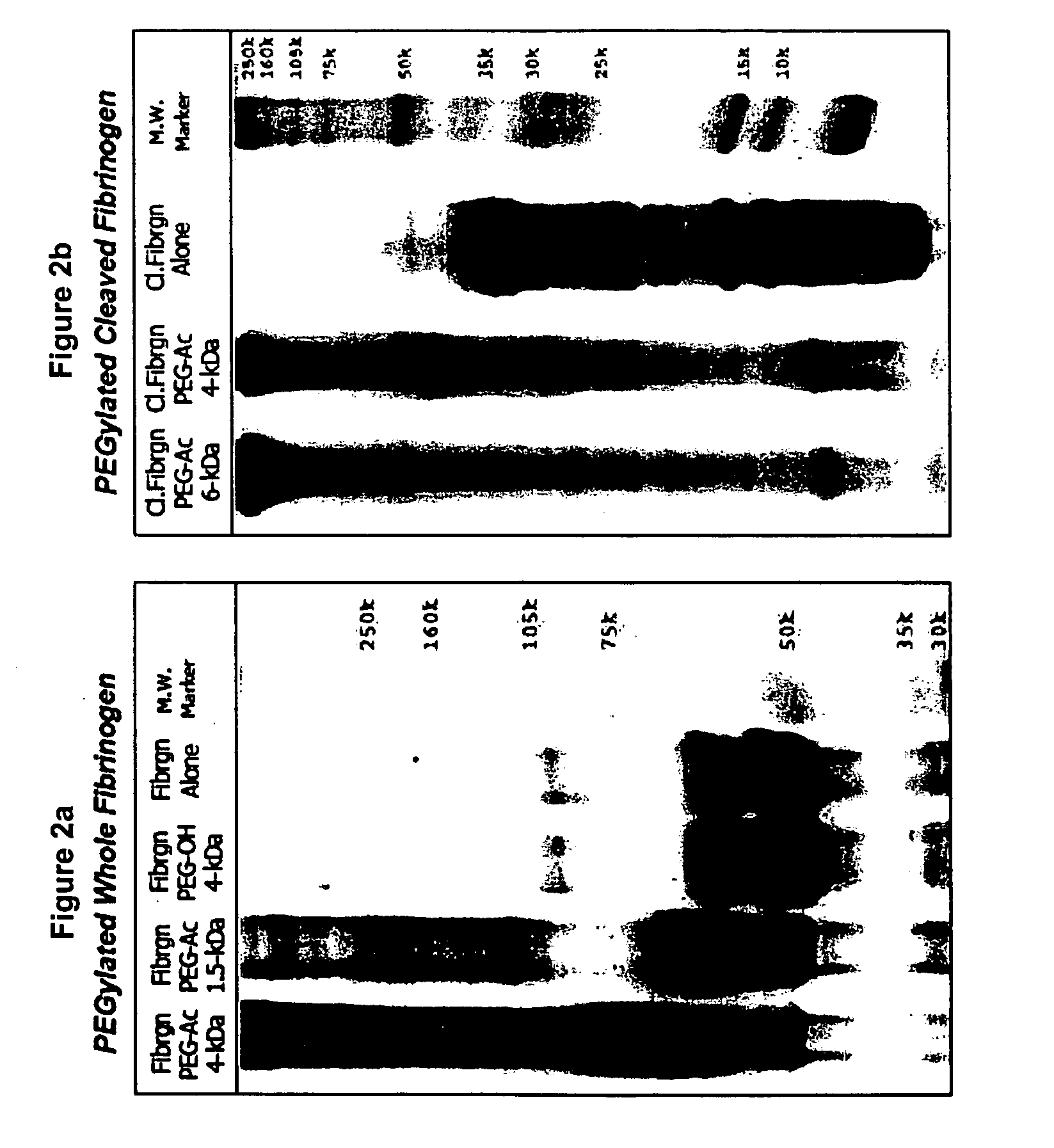Matrix composed of a naturally-occurring protein backbone cross linked by a synthetic polymer and methods of generating and using same
a naturally occurring protein and synthetic polymer technology, applied in the field of disorders, can solve the problems of high anisotropic tissue with altered growth kinetics, limited cell migration into the depth of synthetic scaffolds, and many prefabricated materials subject to uneven cell seeding, etc., and achieve the effect of high magnification
- Summary
- Abstract
- Description
- Claims
- Application Information
AI Technical Summary
Problems solved by technology
Method used
Image
Examples
example 1
Precursor Preparation
[0150] The blood-borne protein molecule fibrinogen is used to create a hybrid precursor molecule for tissue regeneration [Dikovsky et al., Biomaterials 27(8), 14-96-506, 2006; Almany and Seliktar, Biomaterials, 26(15), 2467-77, 2005]. Fibrinogen is the precursor to the commonly known blood clot protein, fibrin. The fibrinogen molecule contains a set of biological cell-signaling cues specific to cellular remodeling, including the cell-adhesive sequence Arg-Gly-Asp (RGD) and a protease degradation substrate [Herrick, Int J Biochem Cell Biol, 31(7) 741-6,1999]. The fibrinogen molecules are transformed into a biosynthetic hybrid precursor using four sequential steps: 1) fibrinogen denaturation; 2) cleavage (optional); 3) PEGylation; 4) and 3-D matrix formation (optional). Each of these steps is detailed infra.
[0151] Step 1—Fibrinogen Denaturation: Denatured fibrinogen was prepared by incubating purified fibrinogen in a reducing a solution containing a high excess ...
example 2
Denatured PEGylated Fibrinogen Degradation
[0157] The degradation of denatured or fragmented PEGylated fibrinogen into PEGylated fibrinogen degradation products was verified experimentally using an in vitro degradation assay. Basically, PEGylated denatured / fragmented fibrinogen fragments are formed into a matrix to recreate a 3-D matrix which can be implanted into a site-specific defect.
[0158] Several variations of the PEGylated fibrinogen fragments are used in these experiments, including cleaved and whole protein with either 6-kDa or 10-kDa PEG-DA attached to the protein. Protease degradation of the denatured PEGylated fibrinogen is measured by colorimetrically assessing the release of the PEGylated fibrinogen degradation products into the supernatant during the course of the experiments. Cylindrical plugs are cast in 5 mm diameter silicon tubes from 100 μl aliquots of PEG-fibrinogen precursor solution containing photoinitiator. The degradation is quantified by labeling the PEGyl...
example 3
[0165] The protease-mediated release of the denatured PEGylated fibrinogen products from intact 3-D materials may have a profound chemotactic effect on in vitro tissue cultures of various types. It is assumed that when released from the 3-D matrix, the denatured PEGylated fibrinogen degradation products may facilitate the chemotactic invasion of cells, including vascular smooth muscle cells, chondrocytes, and embryonic stem cells, into the 3-D matrix containing the bound PEGylated fibrinogen. Therefore, the chemotactic potential of the denatured PEGylated fibrinogen degradation products was assayed by an in vitro tissue culture assay designed in part for this task.
[0166] Chemotaxis assay—A cell invasion assay was employed using smooth muscle tissue encapsulated by a PEGylated fibrinogen matrix (10 kDa PEG). Dense tissue constructs composed of smooth muscle cell-seeded collagen gels placed inside PEG-fibrinogen hydrogels. The smooth muscle tissue constructs were...
PUM
| Property | Measurement | Unit |
|---|---|---|
| PEG-DA | aaaaa | aaaaa |
| PEG-DA | aaaaa | aaaaa |
| molar ratio | aaaaa | aaaaa |
Abstract
Description
Claims
Application Information
 Login to View More
Login to View More - R&D
- Intellectual Property
- Life Sciences
- Materials
- Tech Scout
- Unparalleled Data Quality
- Higher Quality Content
- 60% Fewer Hallucinations
Browse by: Latest US Patents, China's latest patents, Technical Efficacy Thesaurus, Application Domain, Technology Topic, Popular Technical Reports.
© 2025 PatSnap. All rights reserved.Legal|Privacy policy|Modern Slavery Act Transparency Statement|Sitemap|About US| Contact US: help@patsnap.com



